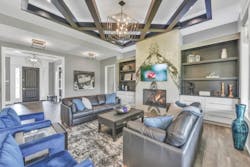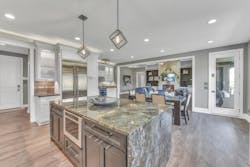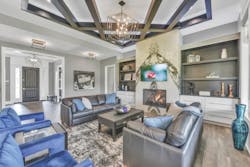One Custom Builder's Model for Staying Ahead of the Curve
The model home in Northville, Mich., is unusual, not least because it belongs to a custom home builder, and custom builders usually build to order from the ground up for clients, so they have little need for models. Besides, Compo Builders, in Novi, Mich., has done just fine showing off its work during the 12 years since it last built a model home.
What’s unusual—perhaps “innovative” is more apt—is how 45 light bulbs in the Lisa, as the 2,800-square-foot ranch model home is named, act as the control hub for all of the home’s connected devices.
When Compo Builders’ president, David Compo, first saw the Juno AI light fixture two years ago as a prototype in his boardroom, he was about to begin his term as president of the Home Builders Association of Southeastern Michigan. And, as a way to get more press coverage for the local Parade of Homes, he wondered if anyone had ever built a house where Amazon Alexa was the control platform instead of a wired or centralized system.
Some of the home’s Juno AI downlights are Amazon Alexa-enabled and, through voice activation, can turn on and off and adjust the smart devices in the home.
Photo courtesy Compo Builders
Compo wanted to build a home like no other in Southeast Michigan and trick it out with the cutting-edge technology he and his director of operations, Brian Herrick, had seen during their six years attending the TecHome Builder Summit. With program tracks for luxury home, production home, and multifamily, TecHome’s invitation-only events had exposed Compo and Herrick to the latest home-tech innovations.
“We don’t know what we don’t know as builders, and we wanted to set ourselves apart with products we’ve seen at the TecHome Summit,” Compo says. “Also, homebuyers don’t know what they don’t know until they see the current products that are out there.” With that, the idea for the Lisa model home was born.
Juno AI is a 6-inch recessed downlight that features an LED bulb that mimics circadian rhythms. Available models include the downlight, a downlight speaker light, and an LED voice-control speaker light with Alexa built in, so the fixture’s voice activation allows residents to not only control lighting and music but to open and close the garage door, secure and open door locks, control window blinds, and adjust the thermostat and any other Alexa-connected device.
Photo: courtesy Compo Builders
“We said, ‘Let’s see how much Alexa control we can get by getting all of these devices on it,’” Compo says. “I can walk into the house and say, ‘Alexa, turn off the alarm.’ When I say, ‘Alexa, good morning,’ the blinds go up, the lights come on to preset levels, and the music starts. When I say ‘good afternoon,’ a whole different thing happens, and saying ‘good night’ shuts everything down and it gets ready to turn on the alarm.”
The house also has an extra layer of control with 75 Legrand smart switches throughout that are touch and motion activated and Alexa capable. Additional control is also possible through a smart phone or other smart device. “The more technology, the more potential there is for problems,” Compo says, “but when you get a platform that includes a switch, usually you’re not going to run into a problem because there is more than one way to control it, and in the worst case, you don’t have to rely on technology to do it.”
Among the Lisa model’s tech features that Compo can show off to clients are a color camera system with DVR, a security system, Hunter Douglas automatic blinds, on-demand water heater, Schlage door locks, a Ring doorbell, and StreamLabs’ water leak detection system, which shuts off the main water valve if it detects a leak as tiny as 1/100 of a gallon. The pipeline is a Luxul (soon to be part of Legrand AV) mesh network with six wireless access points that can accommodate 200 IP addresses. “The mesh network is the key,” Compo says. “As soon as homeowners go in the direction of having a lot of devices, we know they need a network. The biggest thing in the Lisa ranch is that every switch in it is an IP address, so there’s a lot.”
Photo: courtesy Compo Builders
Compo has been striving to stay ahead of the home tech curve since his days of linking smart devices to the HomeLogic platform, until it was acquired by Elan Home Systems in 2007. Now, with the Lisa model home, the builder has a tangible tool for upselling, but the model home hasn’t changed Compo and Herrick’s basic approach. Every Compo Builders home starts with an initial $10,000 allowance for home tech. The builder then asks a range of questions about the client’s lifestyle to ascertain whether $10,000 will be enough or too little an allowance. “I’m not going to tell people what they should have,” Compo says. “Many of our questions are security based: What is your concern? (It could be the yard or the front of the house.) Do you want security cameras? How many? How far do you want to tilt your cameras? We’ve done some homes where there are 20 cameras, while a typical house usually has four: two in the backyard, one in the drive, and one at the front door.
“Then we ask about monitoring: How often do you travel? How do you want to monitor the house when you’re away? Do you want to shut off security from your phone when guests come in? Do you want to open your overhead garage door for a delivery? When you come home alone after dark, do you want a security path that turns on the outside and inside garage lights and kitchen lights, all by pressing the garage door control?”
If the client entertains, Compo asks about how often and how important it is for them to be able to set up music and lighting without running all over the house to adjust dimmer switches. If the client wants an indoor pool/spa, would they be interested in humidity control and a camera in that space? Then the pair walk clients through the plan room by room. Does the homeowner want voice-activated circadian-rhythm vanity lights with speakers? How about music in the shower?
Depending on how much home automation the client wants, Compo will suggest adjusting the technology allowance up or down and adding the dollar amount to the mortgage. Seventy-five percent of his clients are engineers, so they’re tech-savvy and tend to want a lot of home tech. He has built houses with a $500,000 allowance just for technology, while other, typically older, clients may just want a Ring doorbell and TVs, and will only need a $5,000 tech allowance. Either way, Compo will estimate a prewired and a finished cost, so that if the homeowner wants to add something later, doing so will be easier than tearing up a wall.
“We try to be on the cutting edge,” Compo says. “And whenever we build a model or a spec home, we use the product ourselves first—we’re the guinea pigs. We won’t recommend anything to a client—unless they demand it—that we’re not familiar with or that’s untested.”



